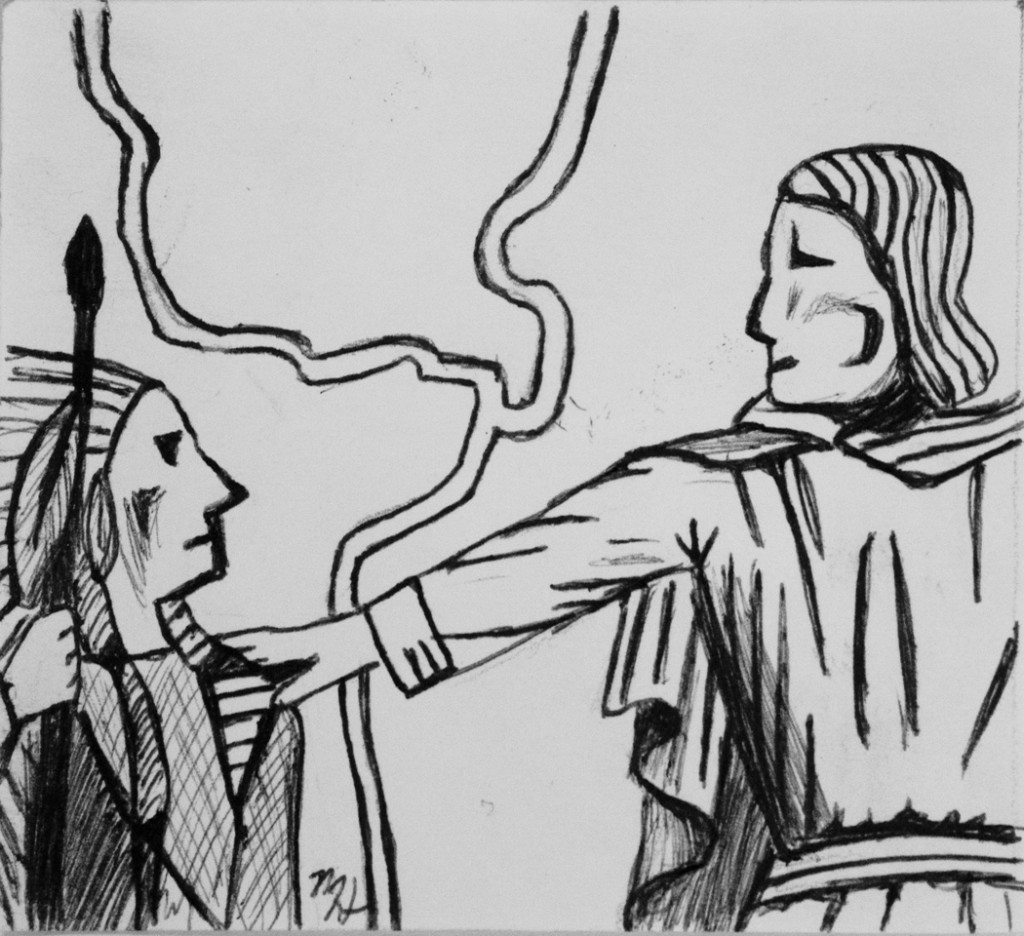
Probably the most controversial and misunderstood of all the artwork on the Saint Louis University campus in St. Louis is a sculpture of a Catholic missionary and his followers.
Tall and stern, a weathered image of Fr. Pierre DeSmet S.J. towers over those of two Native Americans. The priest holds up a crucifix, while the other men, whose plumed headwear makes clear their ethnicity, kneel in awe.
Generations of students in the Mound City have derided the sculpture, reading into it the subjugation of Native American societies by European Christians. But like weathered bronze turned green by the elements, there’s something brighter just below the surface.
The sculpture actually represents a documented historical event from which Fr. DeSmet and his contemporaries drew inspiration.
Bishop Louis William Valentine DuBourg (after whom DuBourg Hall is named) had been appointed to serve the souls in Florida and the 828,000-square-mile territory the United States had acquired in the Louisiana Purchase. He often wrote of the visits he received from various indigenous people of the American West.
In 1820, a delegation of chiefs of the Osage Nation, in full ceremonial dress, traveled to the bishop’s residence in St. Louis to ask him to visit their homes and minister to their people. Their oral traditions had noted their ancestors’ friendly encounters with Jesuit missionaries in decades past.
This man they addressed as “Chief of the Blackrobes” suddenly noticed his guests gazing up at the crucifix on his wall. Having been told what their ancestors had learned from missionaries about Jesus’ sacrifice on the cross, they bowed their heads in reverence and fell to their knees.
The bishop recognized Christ’s spiritual presence in them and understood that they had been sent to him by God.
Longing to take them up on their invitation but also realizing that he could not forsake his pastoral obligations in St. Louis, Bishop DuBourg asked Fr. Charles de la Croix S.J. to visit the Osage and baptize the children of those who requested it.
The priest began with the main Osage village in present-day Bates County, about 60 miles south of where the Missouri and Kansas rivers come together, according to the late Fr. William B. Faherty S.J., Missouri author and historian.
Fr. de la Croix traveled to other Osage villages later that year, offering gifts and baptizing many children at their parents’ requests.
Members of what is now Shrine of St. Patrick Catholic Church in Morgan County near the Lake of the Ozarks trace their parish’s origin to Fr. de la Croix’s arrival, when many of the Osage people in that area came into the Church and continued to practice the faith.
Fr. DeSmet and a handful of other Belgian missionaries arrived in Missouri a few years later. Most wound up following Fr. de la Croix’s footsteps out to the woods and plains, cultivating sacred friendships with numerous Native Americans, negotiating with the government on their behalf, respecting their customs and welcoming into the Church those who wished to be a part of it.
In words, actions and attitudes, DuBourg, de la Croix, DeSmet, Mother Rose Philippine Duchesne and many other frontier missionaries shared the good news that had been handed down through the generations, leading back to the first and greatest missionary, Jesus Christ.
They did this not by imposition, not by fear, but in love, respect, friendship and the recognition of the gift of God’s holiness in the people they were sent to serve.
“Where the rivers meet, DeSmet began,” reads the caption on the wall behind the sculpture of the priest and his newfound parishioners. Long before his massive mission throughout the Missouri River’s upper basin ended, Fr. DeSmet was openly acknowledging that God had made him wiser and holier through the people he had encountered in the mission field.
Nearly 200 years later, his stern likeness reminds all Christians that success in the mission field of life can only be attained by recognizing Christ in other people while offering them the Gospel freely, in love and respect.










